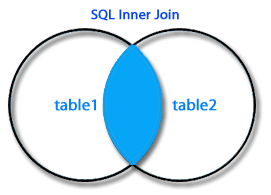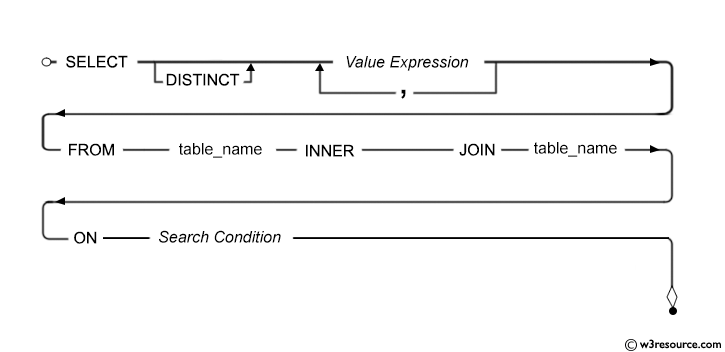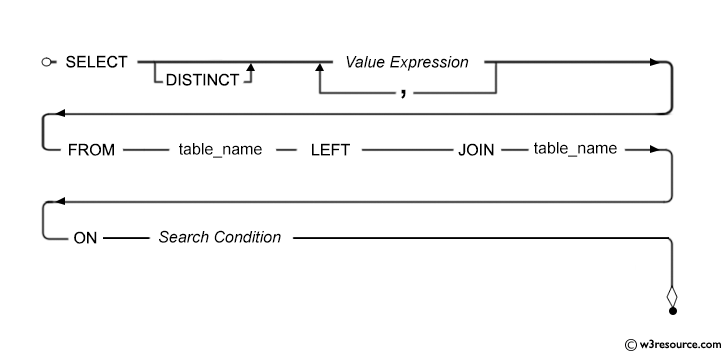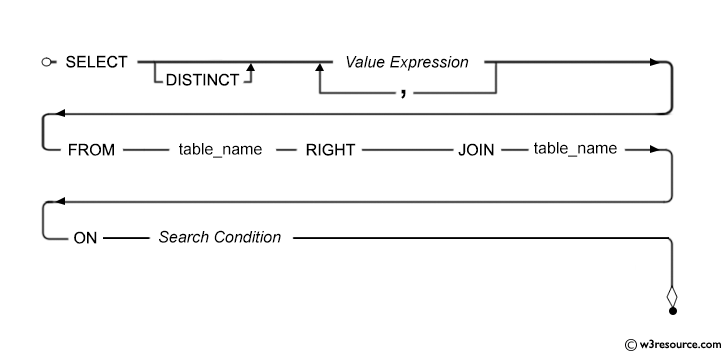Inner Join
The INNER JOIN selects all rows from both participating tables as long as there is a match between the columns. An SQL INNER JOIN is same as JOIN clause, combining rows from two or more tables.
Pictorial presentation of SQL Inner Join:

Syntax:
SELECT * FROM table1 INNER JOIN table2 ON table1.column_name = table2.column_name;
OR
SELECT * FROM table1 JOIN table2 ON table1.column_name = table2.column_name;
The INNER JOIN in SQL joins two tables according to the matching of a certain criteria using a comparison operator.
Syntax diagram - INNER JOIN

Example: SQL INNER JOIN between two tables
Here is an example of inner join in SQL between two tables.
Sample table: foods
Sample table: company
To join item name, item unit columns from foods table and company name, company city columns from company table, with the following condition -
1. company_id of foods and company table must be same,
the following SQL statement can be used :
SQL Code:
Output:
ITEM_NAME ITEM_ COMPANY_NAME COMPANY_CITY ------------------------- ----- ------------------------- -------------- Chex Mix Pcs Akas Foods Delhi Cheez-It Pcs Jack Hill Ltd London BN Biscuit Pcs Jack Hill Ltd London Mighty Munch Pcs Foodies. London Pot Rice Pcs Jack Hill Ltd London Jaffa Cakes Pcs Order All Boston
LEFT JOIN
The SQL LEFT JOIN (specified with the keywords LEFT JOIN and ON) joins two tables and fetches all matching rows of two tables for which the SQL-expression is true, plus rows from the frist table that do not match any row in the second table.
Pictorial presentation of SQL Left Join:

Left Join: Syntax
SELECT * FROM table1 LEFT [ OUTER ] JOIN table2 ON table1.column_name=table2.column_name;
SQL LEFT join fetches a complete set of records from table1, with the matching records (depending on the availability) in table2. The result is NULL in the right side when no matching will take place.
Syntax diagram - LEFT JOIN

Example of SQL Left Join
To get company name and company id columns from company table and company id, item name, item unit columns from foods table, after an OUTER JOINING with these mentioned tables, the following SQL statement can be used :
Sample table: foods
Sample table: company
SQL Code:
Explanation:
This SQL statement would return all rows from the company table and only those rows from the foods table where the joined fields are equal and if the ON clause matches no records in the 'foods' table, the join will still return rows, but the NULL in each column of the right table.
Output:
COMPANY_ID COMPANY_NAME COMPANY_CITY COMPANY_ID ITEM_NAME ---------- ------------------------- ------------------------- ---------- -------------- 16 Akas Foods Delhi 16 Chex Mix 15 Jack Hill Ltd London 15 Cheez-It 15 Jack Hill Ltd London 15 BN Biscuit 17 Foodies. London 17 Mighty Munch 15 Jack Hill Ltd London 15 Pot Rice 18 Order All Boston 18 Jaffa Cakes 19 sip-n-Bite. New York
RIGHT JOIN
The SQL RIGHT JOIN, joins two tables and fetches rows based on a condition, which is matching in both the tables ( before and after the JOIN clause mentioned in the syntax below) , and the unmatched rows will also be available from the table written after the JOIN clause ( mentioned in the syntax below ).
Pictorial presentation of SQL Right Join:

Syntax:
SELECT * FROM table1 RIGHT [ OUTER ] JOIN table2 ON table1.column_name=table2.column_name;
SQL RIGHT join fetches a complete set of records from table2, i.e. the rightmost table after JOIN clause, with the matching records (depending on the availability) in table1. The result is NULL in the left side when no matching will take place.
Syntax diagram - SQL Right Join

Example of SQL Right Join or right outer join
Sample table: foods
Sample table: company
To get company ID, company name and company city columns from company table and company ID, item name columns from foods table, after an OUTER JOINING with these mentioned tables, the following SQL statement can be used:
SQL Code:
Explanation:
This SQL statement would return all rows from the foods table and only those rows from the company table where the joined fields are equal and if the ON clause matches no records in the company table, the join will still return rows, but the NULL in each column of company table.
Output:
COMPANY_ID COMPANY_NAME COMPANY_CITY COMPANY_ID ITEM_NAME
---------- ------------------------- ------------------------- ---------- --------------
18 Order All Boston 18 Jaffa Cakes
15 Jack Hill Ltd London 15 Pot Rice
15 Jack Hill Ltd London 15 BN Biscuit
15 Jack Hill Ltd London 15 Cheez-It
16 Akas Foods Delhi 16 Chex Mix
17 Foodies. London 17 Mighty Munch
Salt n Shake
